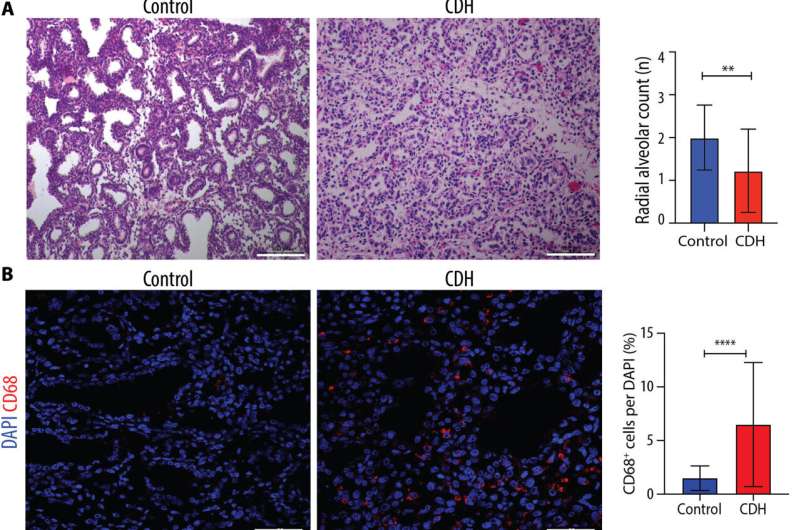This article has been reviewed according to Science X's editorial process and policies. Editors have highlighted the following attributes while ensuring the content's credibility:
fact-checked
peer-reviewed publication
trusted source
proofread
New research into life-threatening birth defect of the diaphragm

Congenital diaphragmatic hernia (CDH) is a dangerous malformation of the lungs and diaphragm that causes almost a third of affected babies to die from underdeveloped lungs.
Medical researchers in Leipzig have made important progress in understanding the disease.
The team led by Dr. Richard Wagner has discovered that the dangerous malformation of the newborn lungs is associated with inflammatory processes involving the increased presence of immune cells. In another study, the researchers, together with colleagues from Canada, show that components of amniotic fluid stem cells can have an anti-inflammatory effect.
The latest results have been published in the journal Science Advances.
CDH affects about one in 2,500 babies. This condition causes a hole in the fetus' diaphragm and, through unexplained processes, prevents the lungs from developing fully before birth. Nearly a third of affected babies die as a result.
"We have known that congenital lung underdevelopment in diaphragmatic hernia is associated with inflammatory processes at the molecular level since we compared the molecular properties of stem cells from normal and underdeveloped lungs of patients with this condition," explains PD Dr. Richard Wagner, assistant physician and research group leader for pediatric surgery at the University of Leipzig Medical Center.
"In that study, we were able to show that lung maturation can be significantly improved by drug therapy with dexamethasone," says the pediatric surgeon. In everyday clinical practice, this steroid is already given to pregnant women who are at risk of preterm delivery. It helps the fetus' lungs to develop as well as possible at an early stage.
Immune cells in underdeveloped lungs
"In a subsequent study, we were able to show that it is primarily the epithelial cells of the lung that are affected by inflammation," says the scientist.
"They are the cells that are located on the surface layer of the lungs and come into contact with the amniotic fluid." Inflammation could explain why lung development stagnates.
"If an organ has to deal with an inflammatory reaction during development, this will impair organ differentiation and growth," says Wagner.
In animal models and in the lungs of human patients, the researchers found specific pro-inflammatory signaling processes there that correlate with an accumulation of macrophages, which are immune system scavenger cells. It is not yet known why these are more likely to migrate to the fetal lungs and possibly trigger the inflammation.
Anti-inflammatory effect of cellular components from amniotic fluid
Scientists in Toronto, with whom the Leipzig researchers are collaborating, took a slightly different therapeutic approach. In a recently published study, they also found inflammatory processes and increased immune cells in animal models of CDH.
So-called extracellular vesicles from stem cells, which the researchers had isolated from the amniotic fluid and multiplied, proved effective against the inflammatory changes. These vesicles are cellular components that move from cell to cell, carrying complex information—including genetic blueprints, such as RNA particles.
In animal models, the researchers found that when they administered such vesicles to pregnant animals, the inflammation was reduced and the lungs of the fetuses were able to develop more normally. However, this method is still a long way from being a potential therapy for humans. "For example, we still need to investigate in detail how the vesicles affect other organ systems in the fetus," says Wagner.
The collaboration with research teams in Boston, US, and Winnipeg and Toronto, Canada, dates back to when Dr. Richard Wagner spent a year and a half in North America as a postdoctoral fellow studying lung underdevelopment in diaphragmatic hernia.
His scientific work in this field has won several awards, most recently the Richard Drachter Award from the German Society of Pediatric and Adolescent Surgery in April.
More information: Lina Antounians et al, Fetal hypoplastic lungs have multilineage inflammation that is reversed by amniotic fluid stem cell extracellular vesicle treatment, Science Advances (2024). DOI: 10.1126/sciadv.adn5405
Florentine Dylong et al, Overactivated Epithelial NF-κB Disrupts Lung Development in Congenital Diaphragmatic Hernia, American Journal of Respiratory Cell and Molecular Biology (2023). DOI: 10.1165/rcmb.2023-0138OC





















